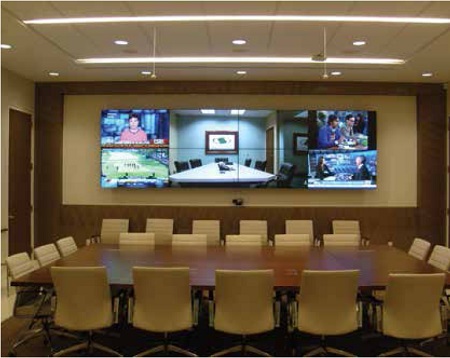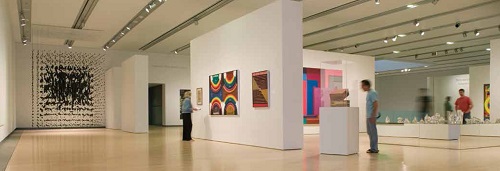New Technologies Making Everyday Installs More Profitable

Interactive Solutions, Inc. has developed new service offerings to ensure the money that a customer spends on conference room technology, like the HD video and audio conferencing and multi-window display capabilities in this integrated boardroom, is maximized. Whenever a statement begins with the phrase, “In a world,” we know something big is coming.
So when Michael Maniscalco, vice president of technology, ihiji, and others in the industry explain that in a world of decreasing product margins, increasing competition and great complexity, many systems integrators are looking at various ways to improve their bottom line, we know it’s universal.
Beyond cost-cutting, newer technologies are making everyday installs more profitable.
“Traditional cost-cutting can only take it so far, and many technology integrators are now implementing software tools that provide improved efficiency as well as a new recurring revenue stream,” Maniscalco said. “With more devices relying on the network for content, control, and communication, it is increasingly more common for integrators to deploy a remote network management solution. These tools let integrators attend to service-related issues proactively and remotely while also improving visibility for troubleshooting.
And as audiovisual and video conferencing technologies continue to evolve with ever decreasing price points and total equipment costs, integrators are having to look for newer ways to increase the profitability of jobs to account for these decreased revenues, as well as exploring new streams of recurring revenue, said Michael Sanders, vice president of business development, Interactive Solutions, Inc.
“We have developed new service offerings to ensure the money that a customer does spend or has already spent on conference room technology is maximized,” he noted. “This includes increased SLA options such as Next Business Day and 24/7, as well as our remote monitoring service, ISI-NET, that creates a sense of confidence with our customers so that when it is time to use the equipment, it will function as planned.”
When an issue does arise, Sanders said, it can be diagnosed and sometimes corrected before it becomes an end-user’s headache. “These offerings also introduce new service and support levels available to our customers in combination with traditional support agreements, or as a stand-alone option if budgets get squeezed.”
A daily selection of the top stories for AV integrators, resellers and consultants. Sign up below.
With the adoption of huddle rooms in the enterprise, companies are moving toward inexpensive soft codecs and BYOD products for business use, remarked Hailey Klein, marketing and communications manager, Vaddio. “This trend is driving many companies, ourselves included, to create peripherals around these soft codecs.”
As corporate users adopt soft clients in their rooms, Vaddio has seen a significant growth in application specific bundles. “Two years ago for example, we did not even have a product to fulfill this need,” she said. “Now however, it is a significant portion of our revenue. Vaddio’s AppSTATIONS support all commonly used soft clients like Skype, Lync, Jabber, and WebEx, etc.”

In large wireless network installations, those with 20 or more wireless access points spread out over a large site, like this one at the Phoenix Art Museum, system deployments can be a long and tedious process. Pakedge’s wireless network controller not only increases system performance, it is equipped with automation and management tools to simplify installations.The Network View
From a network technology perspective, solutions that increase performance, reduce complexity or deployment costs make everyday installation projects profitable, said Benson Chan, vice president of business development, Pakedge Device & Software.
“Our top systems integrators tell us that the wireless network controller, which serves as the brain—the command, coordination and control center of a wireless network with multiple access points—is a significant profit contributor to their wireless network projects,” he noted. “While it adds to the overall initial cost of the system, the performance increase offsets potential customer concerns and provides the integrator with a profitable upsell on the equipment, as well as a way to differentiate themselves from other competitors.”
In large wireless network installations, those with 20 or more wireless access points spread out over a large site, system deployments can be a long and tedious process. “One of the values of the controller is that in addition to increasing system performance, our controller is equipped with automation and management tools to simplify installations,” Chan said. “As an example, our integrators tell us that by using a controller, they were able to reduce an allday installation project down to two hours. This simplifies the deployment process, reduces the size of the installation crew and reduces install time. The result is lower installation costs, with the savings passed back to the integrator in the form of higher profitability.”
Always Be Closing
The current market environment also has provided a great opportunity to re-evaluate room design concepts and operational approaches in an effort to increase efficiencies along many fronts. “One example is looking at wireless presentation technologies, such as Barco ClickShare, AMX ENZO , Crestron AirMedia, etc., not only as a great way for customers to limit cables and single input locations in conference rooms, but as a way to reduce the amount of onsite installation time required since cable runs, core drills, table cutouts, etc. become a non-issue,” Sanders pointed out.
The bottom line for your bottom line? Additionally, these services bring a new recurring revenue stream to an integrator’s business through a managed service contract or preventative maintenance agreement, Maniscalco concluded. “The benefits are two-fold; reduced ongoing service expenses and recurring revenue, both of which improve profitability.”
Karen Mitchell is a freelance writer in Boulder, Colorado.
Selling Peace of Mind
For systems integrators accustomed to selling equipment, the managed services business can be challenging.
“Products can be seen, touched and experienced, while the managed service is less tangible,” said Chan. “Integrators who have successfully made the transition do three things consistently. First, they understand that they sell peace of mind. Discussions on benefits, ROI and other financial analyses are nothing more than justifications for the underlying customer need.”
Secondly, he noted, they differentiate their managed services offerings from other commodity offerings in the marketplace. “They accomplish this by thinking in terms of customer outcomes and ask ‘why, what and how?’ to give the customer what he or she really wants, and not what they asked for. The differentiated offering often integrates multiple and separate technology/service offerings into one solution, managed through new processes and delivered in ways that customers want.”
And, Chan added, they don’t stop selling when the customer signs the service contract. “Although the customer may not see the service being rendered, they are reminded of the value provided through proactive and continuous communication through monthly reports, incident notifications, problem resolutions, emails or phone calls. When it is time for contract renewals, customers already know the exact value of the services provided.”
—KM
